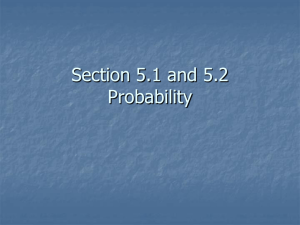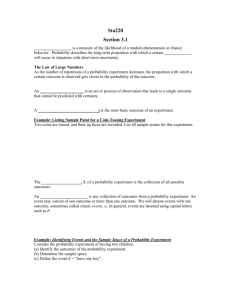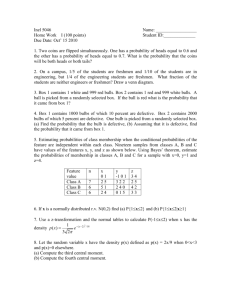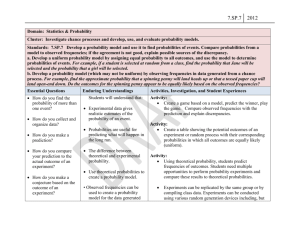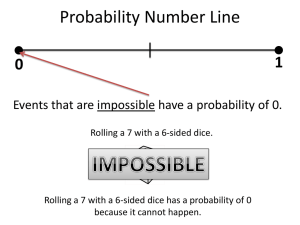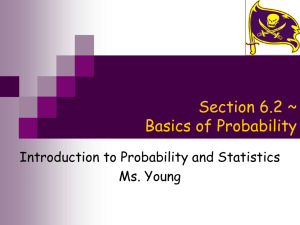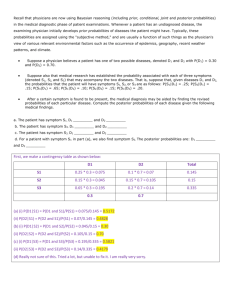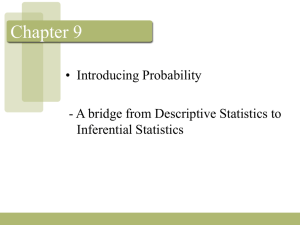Section 6.2 ~ Basics of Probability Objective: After this section you
advertisement
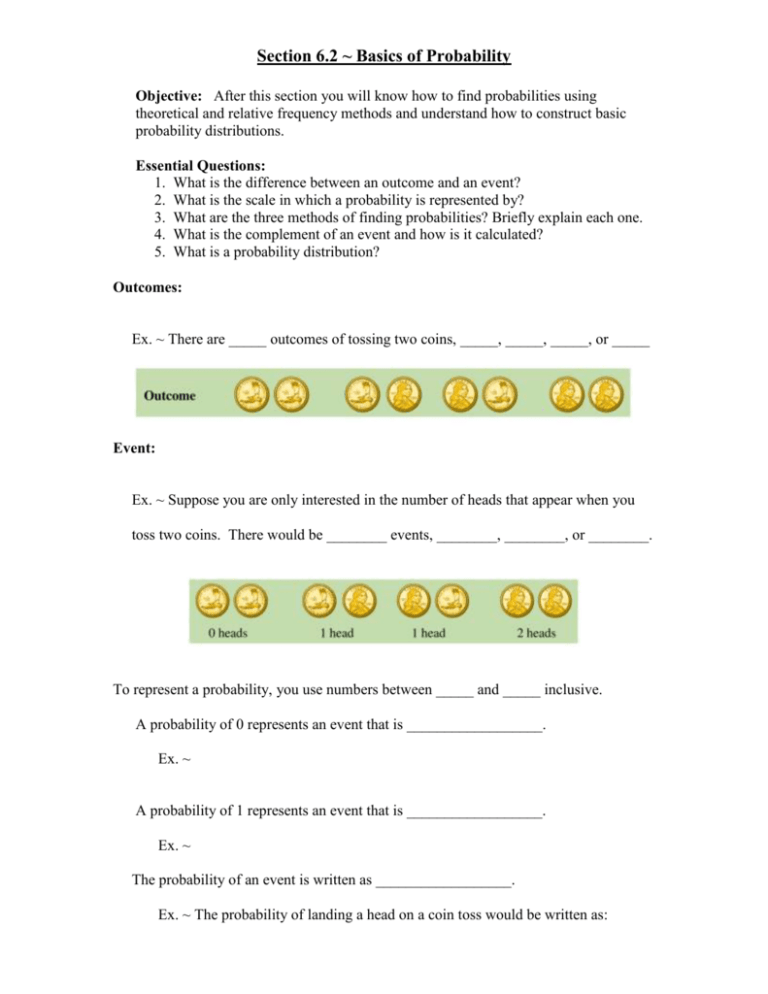
Section 6.2 ~ Basics of Probability Objective: After this section you will know how to find probabilities using theoretical and relative frequency methods and understand how to construct basic probability distributions. Essential Questions: 1. What is the difference between an outcome and an event? 2. What is the scale in which a probability is represented by? 3. What are the three methods of finding probabilities? Briefly explain each one. 4. What is the complement of an event and how is it calculated? 5. What is a probability distribution? Outcomes: Ex. ~ There are _____ outcomes of tossing two coins, _____, _____, _____, or _____ Event: Ex. ~ Suppose you are only interested in the number of heads that appear when you toss two coins. There would be ________ events, ________, ________, or ________. To represent a probability, you use numbers between _____ and _____ inclusive. A probability of 0 represents an event that is __________________. Ex. ~ A probability of 1 represents an event that is __________________. Ex. ~ The probability of an event is written as __________________. Ex. ~ The probability of landing a head on a coin toss would be written as: The scale below shows common expressions used to represent probabilities based on their level in comparison to 0 and 1. Ex. ~ A probability of .95 represents an event that is __________________ to occur. Ex. ~ A probability of .30 represents an event that is __________________ to occur. Ex. ~ A probability of .01 represents an event that is __________________ to occur. Theoretical Probabilities Theoretical probabilities: Calculating theoretical probabilities: 1. 2. 3. Example 1: Suppose you select a person at random from a large group. What is the probability that the person has a birthday in July? Assume that there are 365 days in a year. Counting outcomes: Ex. ~ What is the total number of outcomes of tossing two coins? Ex. ~ What is the total number of outcomes of tossing three coins? Example 2: How many outcomes are there if you roll a fair die and toss a fair coin? What is the probability of rolling two 1’s (snake eyes) when two fair dice are rolled? Example 3: What is the probability that in a randomly selected family with three children, the oldest child is a boy, the second child is a girl, and the youngest child is a girl? Assume that having boys and girls is equally likely. Relative Frequency Probabilities Relative frequency (or Empirical) method: Ex. ~ If we observe that it rains an average of 100 days per year, we can estimate the probability of it raining on a randomly selected day to be approximately: General rule for calculating relative frequency probabilities: 1. 2. Example 4: Geological records indicate that a river has crested above a particular high flood level four times in the past 2,000 years. What is the relative frequency probability that the river will crest above the high flood level next year? Subjective Probabilities Subjective probability: Ex. ~ You could make a subjective estimate of the probability that a friend will be married in the next year or the probability that getting a good grade in statistics will help you get the job that you want. Summary of Methods of Finding Probabilities: Theoretical probability – when all outcomes are equally likely, divide the number of ways an event can occur by the total number of outcomes P( A) number of ways A can occur total number of outcomes Relative frequency probability – based on observations or experiments. Divide the number of times the event occurred by the total number of observations P( A) number of times A occurred total number of observations Subjective probability – estimating based on experience or intuition Example 5: Identify the method that resulted in the following statements. a. The chance that you will get married in the next year is zero. b. Based on government data, the chance of dying in an automobile accident is 1 in 7,000 (per year). c. The chance of rolling a 7 with a twelve-sided die is 1/12. Sometimes you might be interested in finding the probability that a particular event or outcome does not occur. Ex. ~ The probability of a wrong answer on a multiple choice question with five possible answers. The complement of an event: Example 6: In a grocery store the scanning system was successful 384 out of 419 times. What is the probability that the scanner will not work? Probability Distributions Probability distribution: Ex. ~ Suppose you toss two coins simultaneously. Because each coin can land one of two ways (H or T), there are 4 possible outcomes (HH, TT, HT, & TH). The following table represents the outcomes and probabilities: Out of the 4 outcomes, there are 3 events, 2 heads (HH), 1 head (HT or TH), and 0 heads (TT). These probabilities result in a probability distribution which can represented as a table or a histogram: Steps to making a probability distribution: 1. 2. 3. Example 7: Make a probability distribution table for the number of heads that occur when three coins are tossed simultaneously.

